Python Data Scientiest Resume Examples
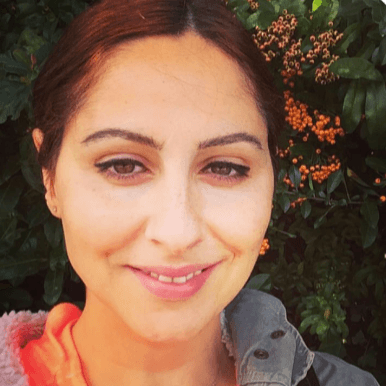
Jul 18, 2024
|
12 min read
Nail your Python data scientist resume: a simple guide to crafting a resume that decodes your skills and experience. Learn how to showcase your expertise and land your dream job in the world of data science.
Rated by 348 people
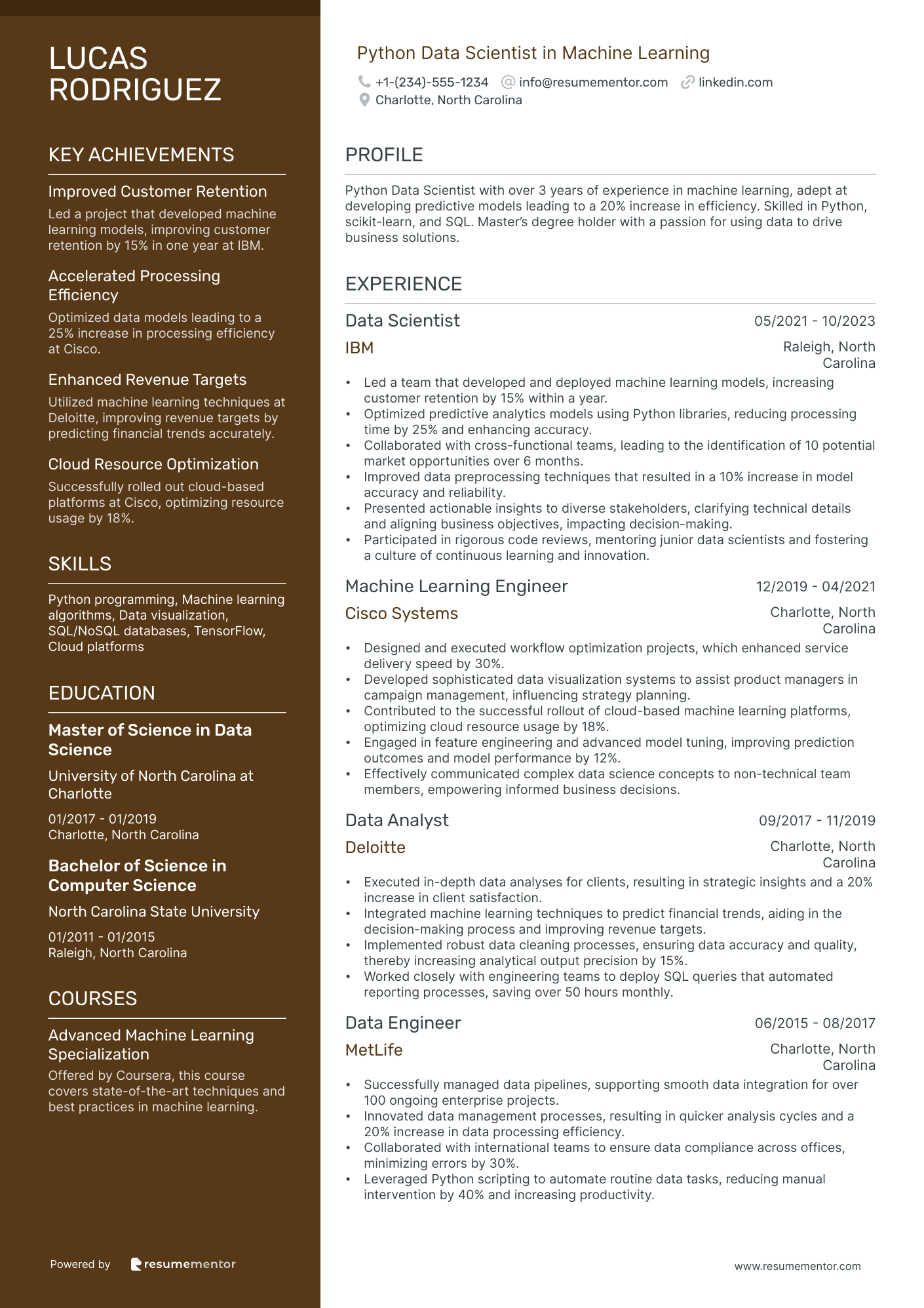
Python Data Scientist in Machine Learning
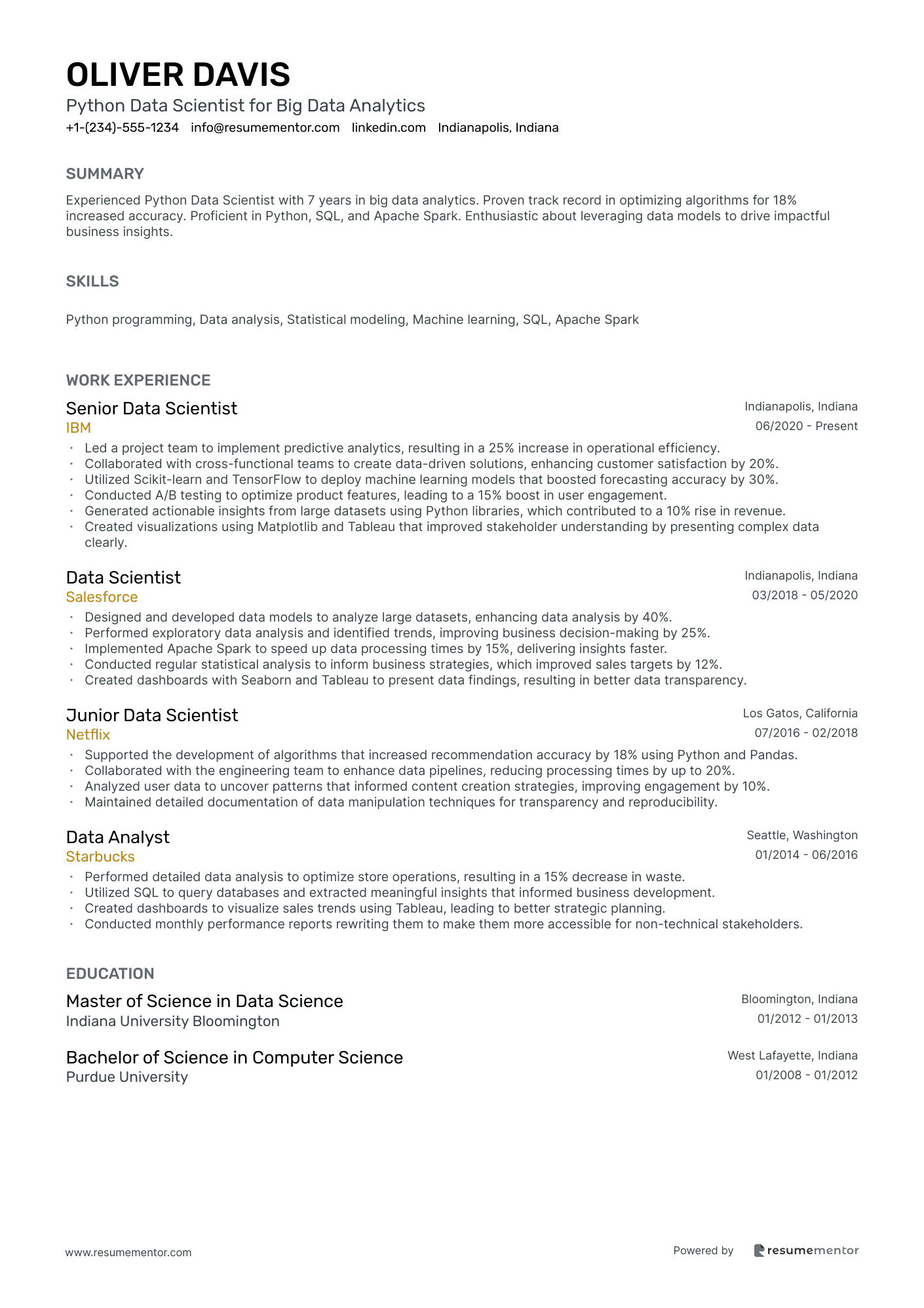
Python Data Scientist for Big Data Analytics
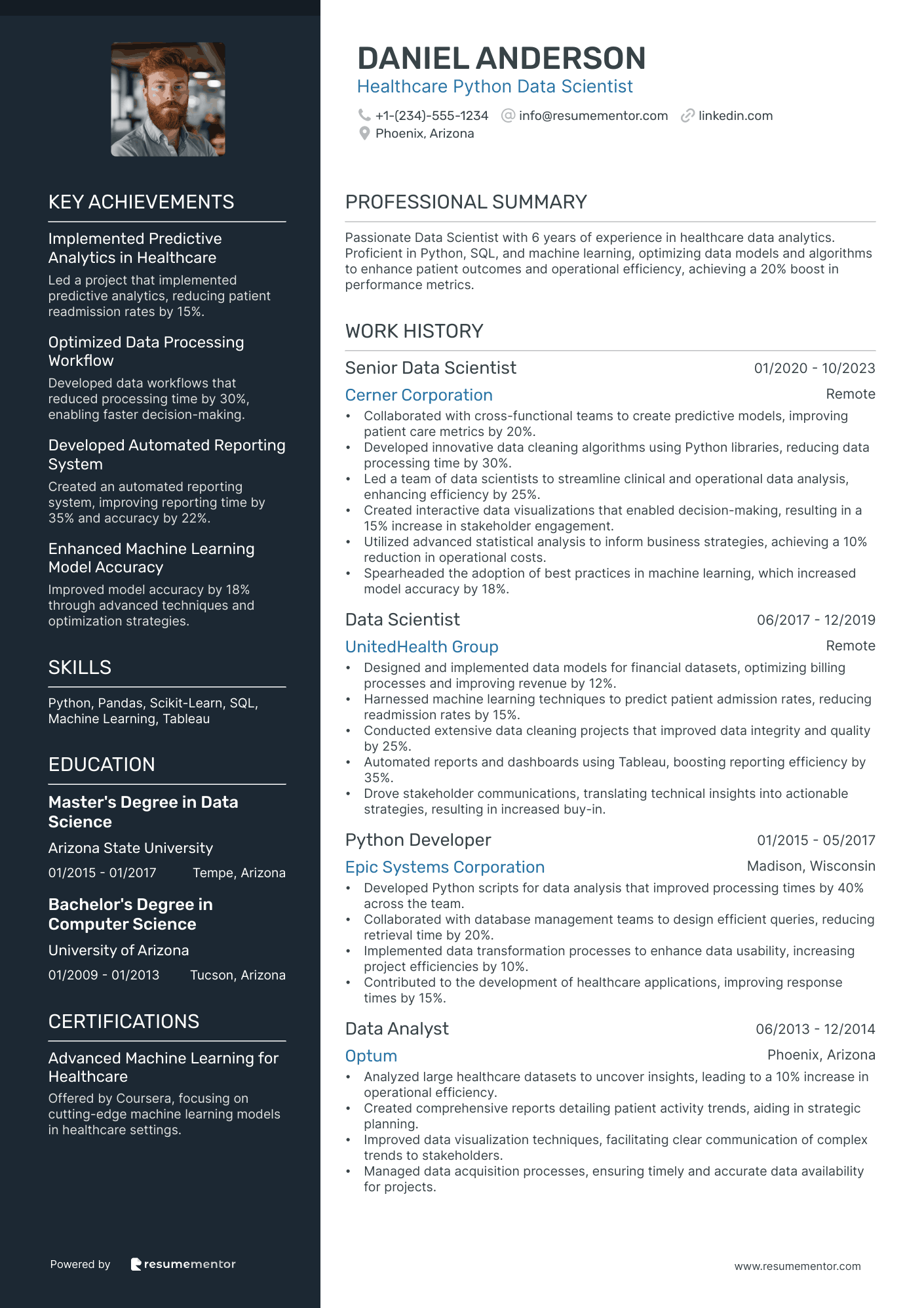
Healthcare Python Data Scientist
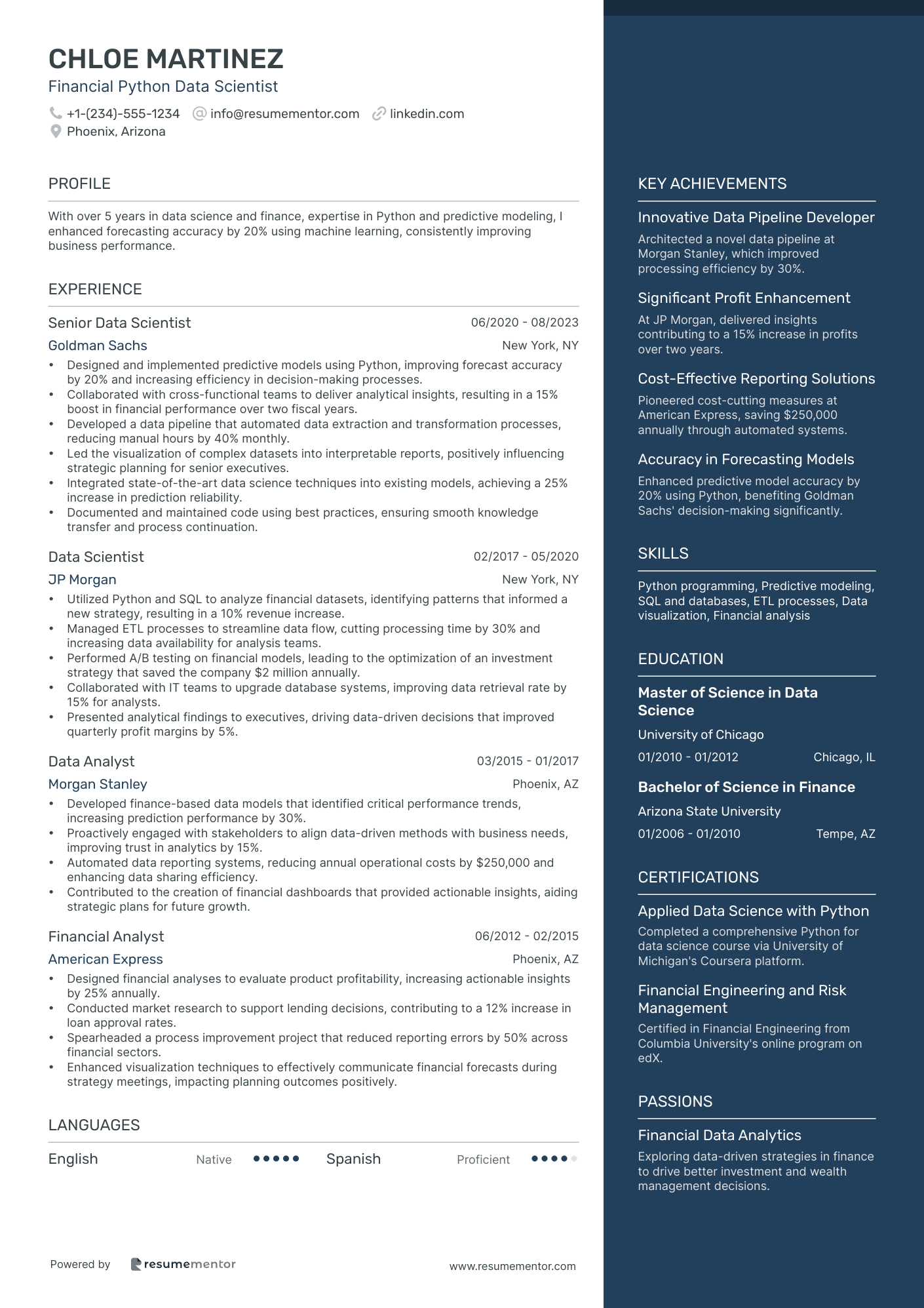
Financial Python Data Scientist
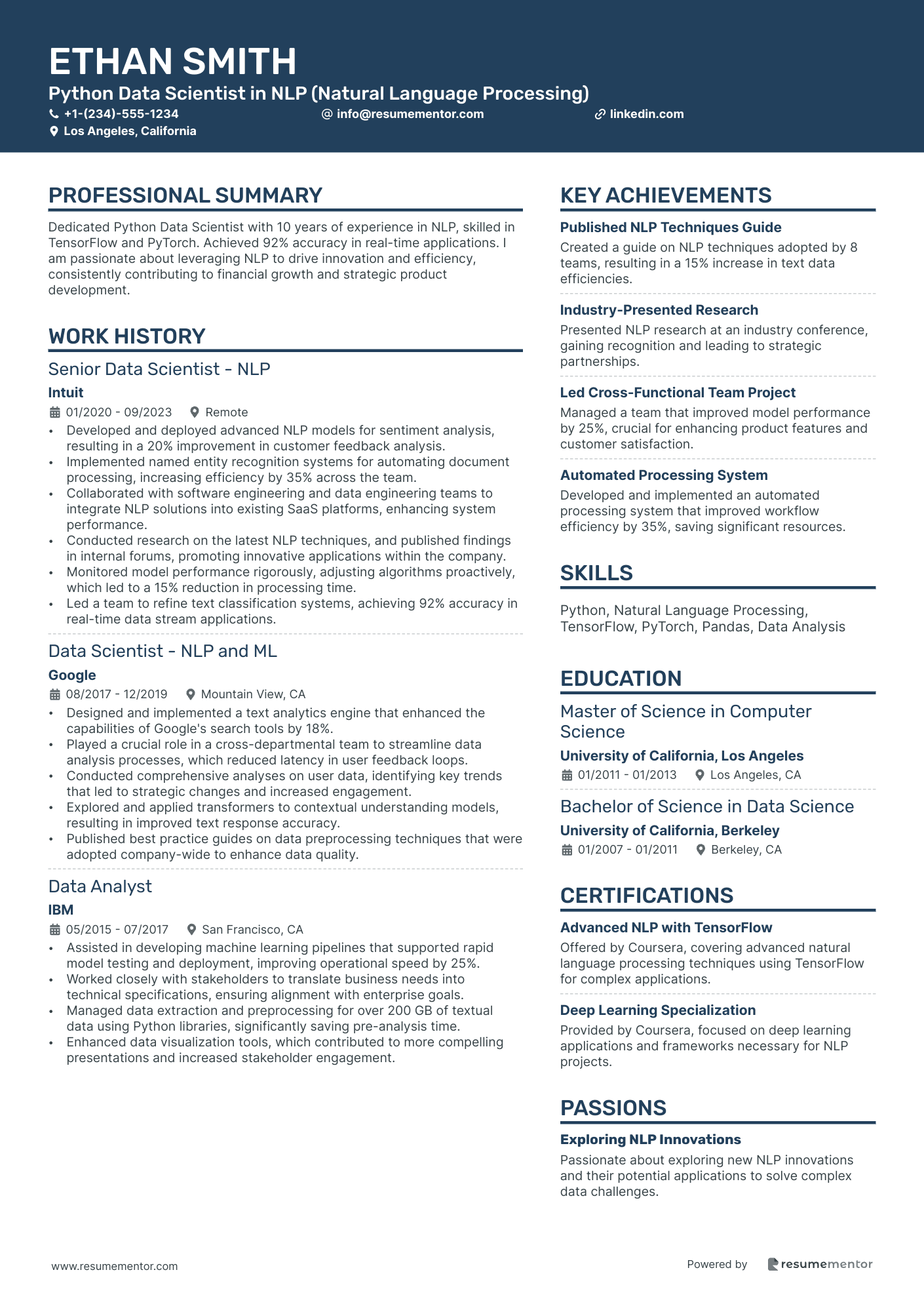
Python Data Scientist in NLP (Natural Language Processing)
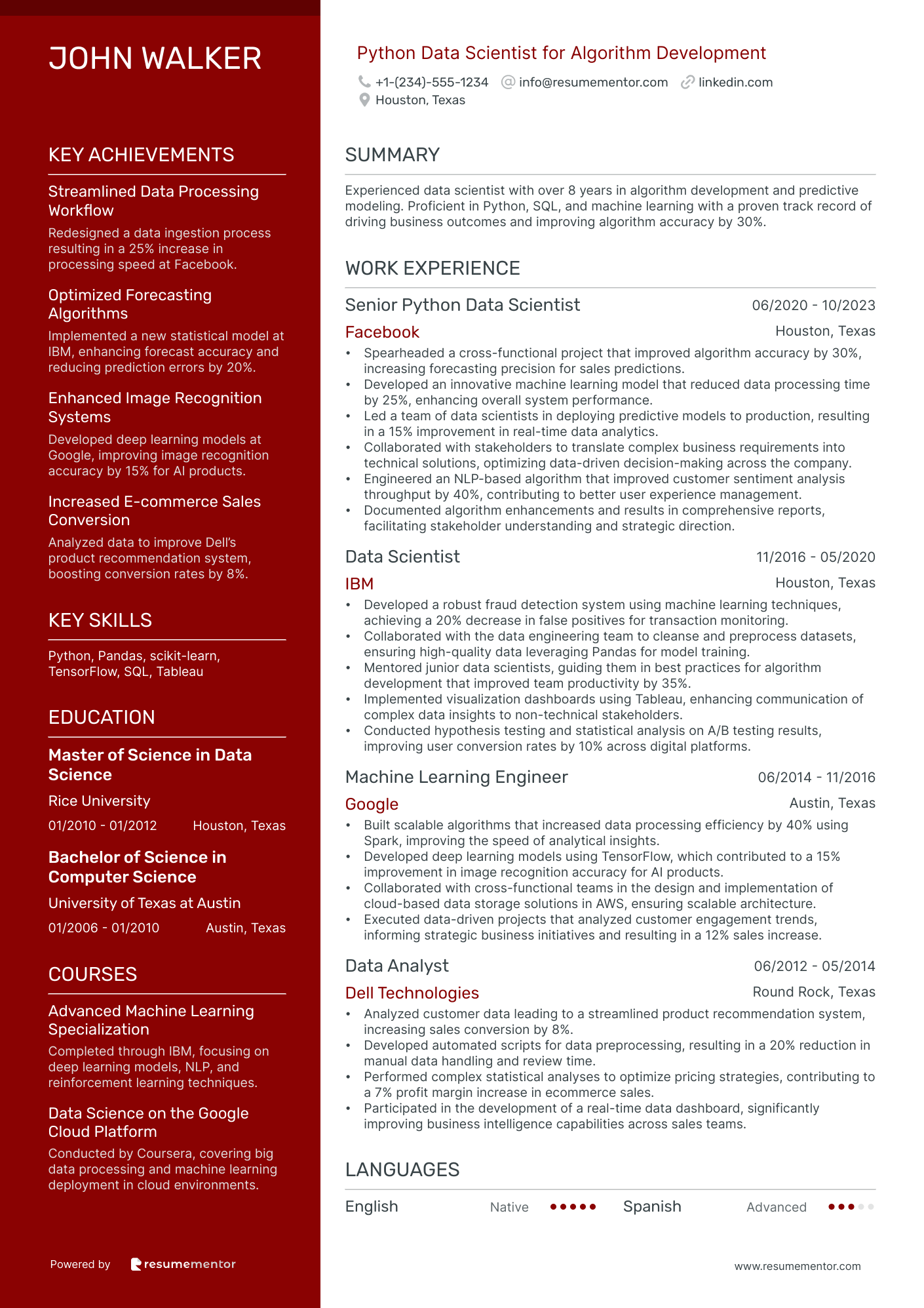
Python Data Scientist for Algorithm Development
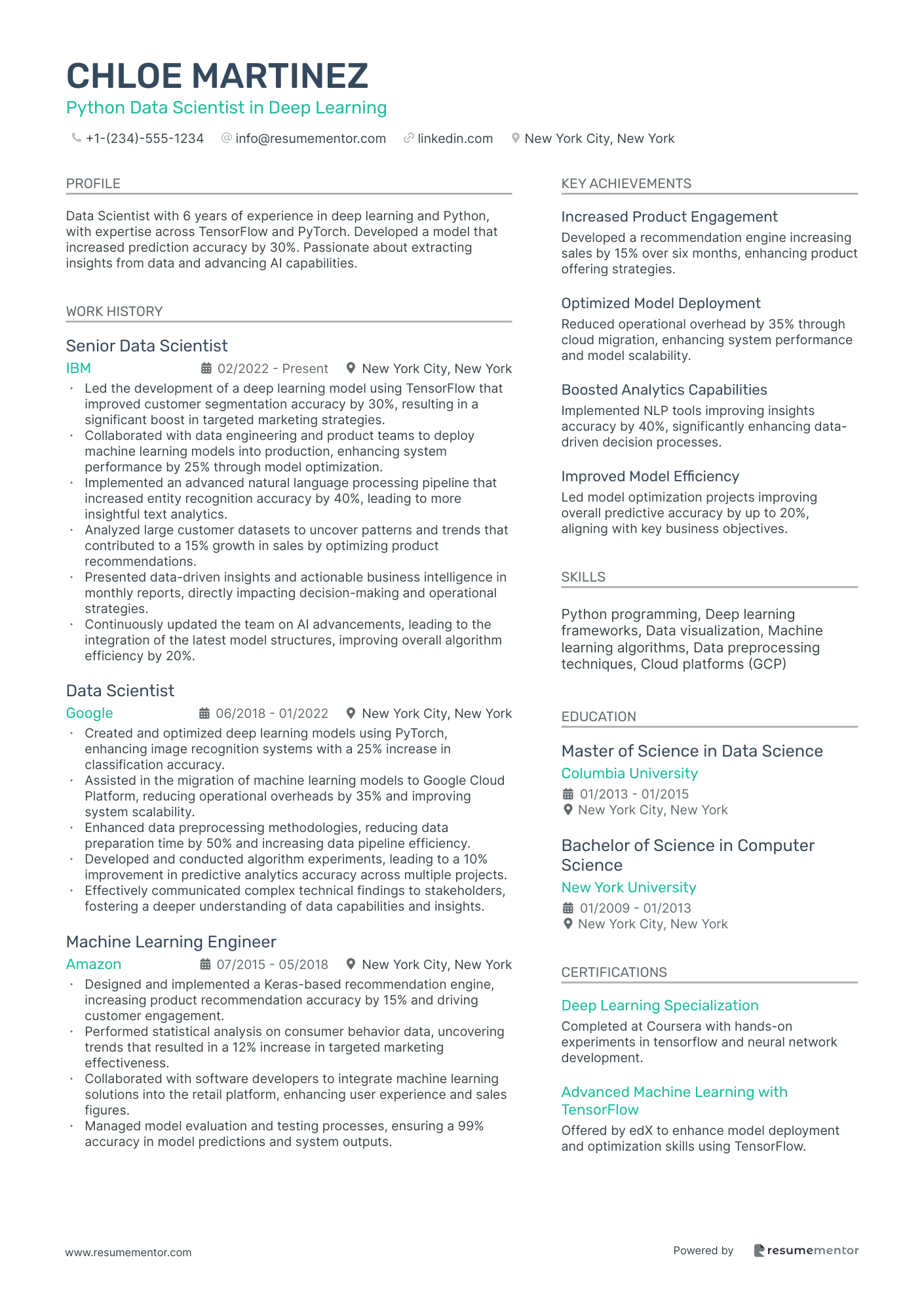
Python Data Scientist in Deep Learning
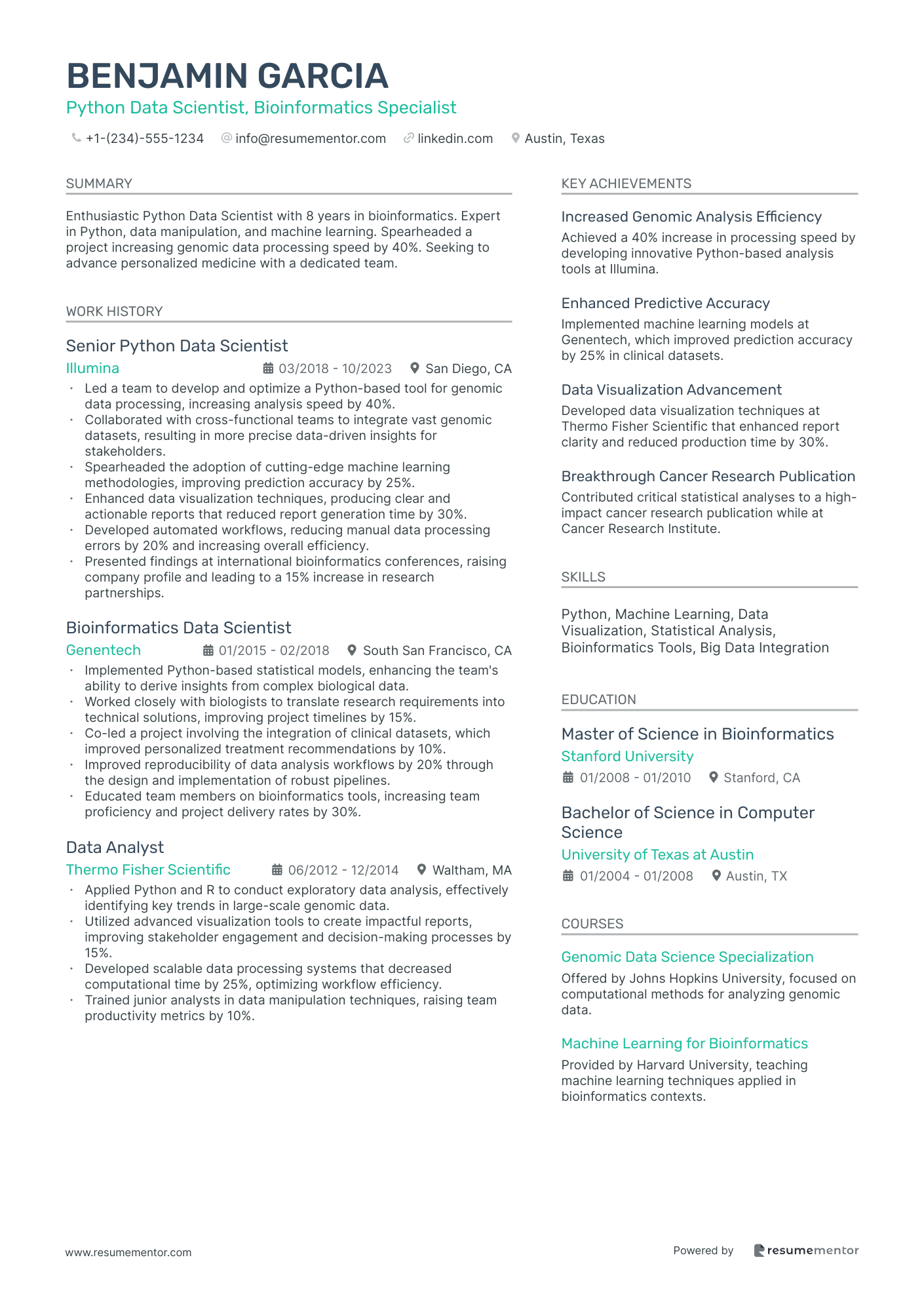
Python Data Scientist, Bioinformatics Specialist
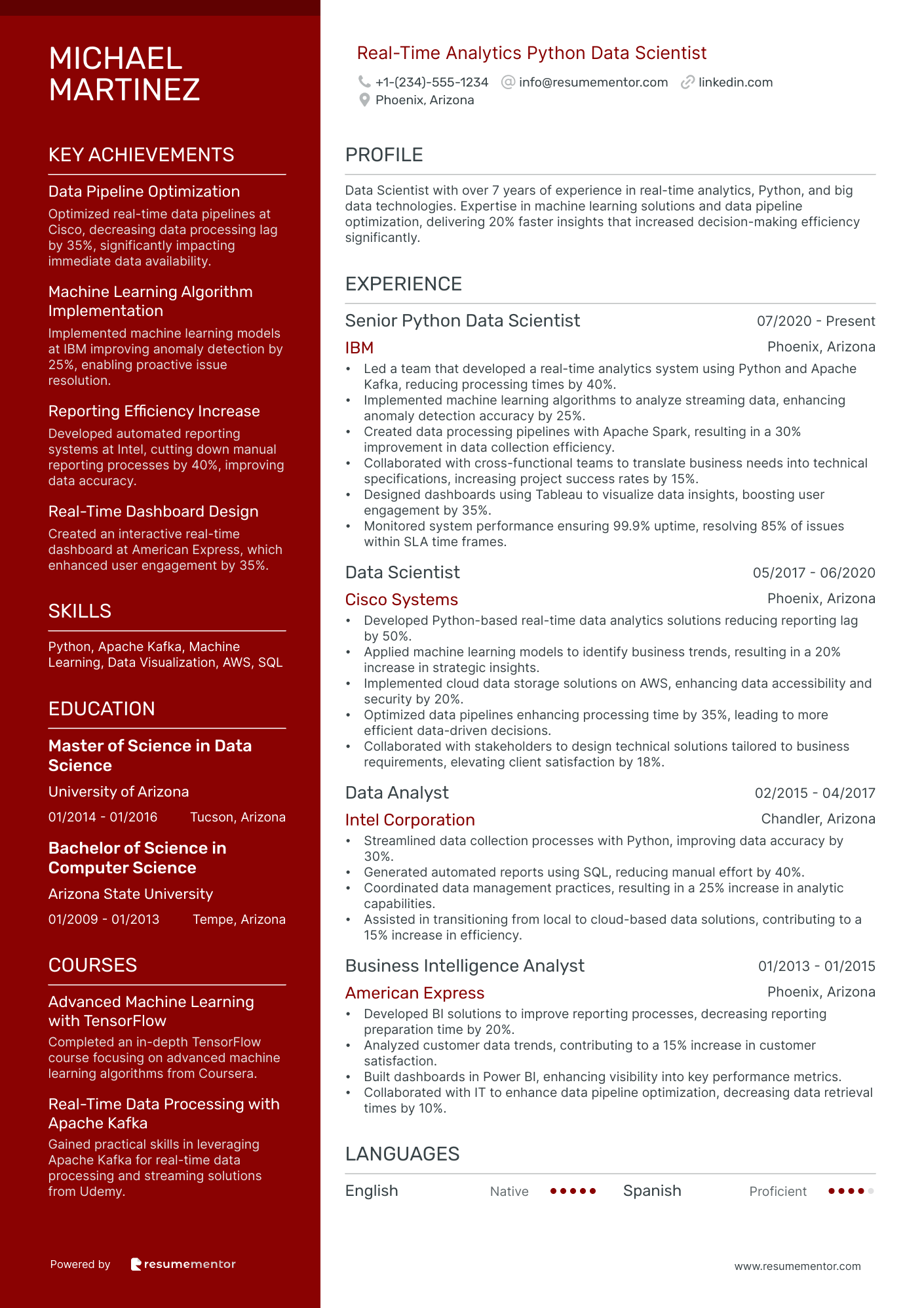
Real-Time Analytics Python Data Scientist

Python Data Scientist with focus on Artificial Intelligence

Python Data Scientist in Machine Learning resume sample
- •Led a team that developed and deployed machine learning models, increasing customer retention by 15% within a year.
- •Optimized predictive analytics models using Python libraries, reducing processing time by 25% and enhancing accuracy.
- •Collaborated with cross-functional teams, leading to the identification of 10 potential market opportunities over 6 months.
- •Improved data preprocessing techniques that resulted in a 10% increase in model accuracy and reliability.
- •Presented actionable insights to diverse stakeholders, clarifying technical details and aligning business objectives, impacting decision-making.
- •Participated in rigorous code reviews, mentoring junior data scientists and fostering a culture of continuous learning and innovation.
- •Designed and executed workflow optimization projects, which enhanced service delivery speed by 30%.
- •Developed sophisticated data visualization systems to assist product managers in campaign management, influencing strategy planning.
- •Contributed to the successful rollout of cloud-based machine learning platforms, optimizing cloud resource usage by 18%.
- •Engaged in feature engineering and advanced model tuning, improving prediction outcomes and model performance by 12%.
- •Effectively communicated complex data science concepts to non-technical team members, empowering informed business decisions.
- •Executed in-depth data analyses for clients, resulting in strategic insights and a 20% increase in client satisfaction.
- •Integrated machine learning techniques to predict financial trends, aiding in the decision-making process and improving revenue targets.
- •Implemented robust data cleaning processes, ensuring data accuracy and quality, thereby increasing analytical output precision by 15%.
- •Worked closely with engineering teams to deploy SQL queries that automated reporting processes, saving over 50 hours monthly.
- •Successfully managed data pipelines, supporting smooth data integration for over 100 ongoing enterprise projects.
- •Innovated data management processes, resulting in quicker analysis cycles and a 20% increase in data processing efficiency.
- •Collaborated with international teams to ensure data compliance across offices, minimizing errors by 30%.
- •Leveraged Python scripting to automate routine data tasks, reducing manual intervention by 40% and increasing productivity.
Python Data Scientist for Big Data Analytics resume sample
- •Led a project team to implement predictive analytics, resulting in a 25% increase in operational efficiency.
- •Collaborated with cross-functional teams to create data-driven solutions, enhancing customer satisfaction by 20%.
- •Utilized Scikit-learn and TensorFlow to deploy machine learning models that boosted forecasting accuracy by 30%.
- •Conducted A/B testing to optimize product features, leading to a 15% boost in user engagement.
- •Generated actionable insights from large datasets using Python libraries, which contributed to a 10% rise in revenue.
- •Created visualizations using Matplotlib and Tableau that improved stakeholder understanding by presenting complex data clearly.
- •Designed and developed data models to analyze large datasets, enhancing data analysis by 40%.
- •Performed exploratory data analysis and identified trends, improving business decision-making by 25%.
- •Implemented Apache Spark to speed up data processing times by 15%, delivering insights faster.
- •Conducted regular statistical analysis to inform business strategies, which improved sales targets by 12%.
- •Created dashboards with Seaborn and Tableau to present data findings, resulting in better data transparency.
- •Supported the development of algorithms that increased recommendation accuracy by 18% using Python and Pandas.
- •Collaborated with the engineering team to enhance data pipelines, reducing processing times by up to 20%.
- •Analyzed user data to uncover patterns that informed content creation strategies, improving engagement by 10%.
- •Maintained detailed documentation of data manipulation techniques for transparency and reproducibility.
- •Performed detailed data analysis to optimize store operations, resulting in a 15% decrease in waste.
- •Utilized SQL to query databases and extracted meaningful insights that informed business development.
- •Created dashboards to visualize sales trends using Tableau, leading to better strategic planning.
- •Conducted monthly performance reports rewriting them to make them more accessible for non-technical stakeholders.
Healthcare Python Data Scientist resume sample
- •Collaborated with cross-functional teams to create predictive models, improving patient care metrics by 20%.
- •Developed innovative data cleaning algorithms using Python libraries, reducing data processing time by 30%.
- •Led a team of data scientists to streamline clinical and operational data analysis, enhancing efficiency by 25%.
- •Created interactive data visualizations that enabled decision-making, resulting in a 15% increase in stakeholder engagement.
- •Utilized advanced statistical analysis to inform business strategies, achieving a 10% reduction in operational costs.
- •Spearheaded the adoption of best practices in machine learning, which increased model accuracy by 18%.
- •Designed and implemented data models for financial datasets, optimizing billing processes and improving revenue by 12%.
- •Harnessed machine learning techniques to predict patient admission rates, reducing readmission rates by 15%.
- •Conducted extensive data cleaning projects that improved data integrity and quality by 25%.
- •Automated reports and dashboards using Tableau, boosting reporting efficiency by 35%.
- •Drove stakeholder communications, translating technical insights into actionable strategies, resulting in increased buy-in.
- •Developed Python scripts for data analysis that improved processing times by 40% across the team.
- •Collaborated with database management teams to design efficient queries, reducing retrieval time by 20%.
- •Implemented data transformation processes to enhance data usability, increasing project efficiencies by 10%.
- •Contributed to the development of healthcare applications, improving response times by 15%.
- •Analyzed large healthcare datasets to uncover insights, leading to a 10% increase in operational efficiency.
- •Created comprehensive reports detailing patient activity trends, aiding in strategic planning.
- •Improved data visualization techniques, facilitating clear communication of complex trends to stakeholders.
- •Managed data acquisition processes, ensuring timely and accurate data availability for projects.
Financial Python Data Scientist resume sample
- •Designed and implemented predictive models using Python, improving forecast accuracy by 20% and increasing efficiency in decision-making processes.
- •Collaborated with cross-functional teams to deliver analytical insights, resulting in a 15% boost in financial performance over two fiscal years.
- •Developed a data pipeline that automated data extraction and transformation processes, reducing manual hours by 40% monthly.
- •Led the visualization of complex datasets into interpretable reports, positively influencing strategic planning for senior executives.
- •Integrated state-of-the-art data science techniques into existing models, achieving a 25% increase in prediction reliability.
- •Documented and maintained code using best practices, ensuring smooth knowledge transfer and process continuation.
- •Utilized Python and SQL to analyze financial datasets, identifying patterns that informed a new strategy, resulting in a 10% revenue increase.
- •Managed ETL processes to streamline data flow, cutting processing time by 30% and increasing data availability for analysis teams.
- •Performed A/B testing on financial models, leading to the optimization of an investment strategy that saved the company $2 million annually.
- •Collaborated with IT teams to upgrade database systems, improving data retrieval rate by 15% for analysts.
- •Presented analytical findings to executives, driving data-driven decisions that improved quarterly profit margins by 5%.
- •Developed finance-based data models that identified critical performance trends, increasing prediction performance by 30%.
- •Proactively engaged with stakeholders to align data-driven methods with business needs, improving trust in analytics by 15%.
- •Automated data reporting systems, reducing annual operational costs by $250,000 and enhancing data sharing efficiency.
- •Contributed to the creation of financial dashboards that provided actionable insights, aiding strategic plans for future growth.
- •Designed financial analyses to evaluate product profitability, increasing actionable insights by 25% annually.
- •Conducted market research to support lending decisions, contributing to a 12% increase in loan approval rates.
- •Spearheaded a process improvement project that reduced reporting errors by 50% across financial sectors.
- •Enhanced visualization techniques to effectively communicate financial forecasts during strategy meetings, impacting planning outcomes positively.
Python Data Scientist in NLP (Natural Language Processing) resume sample
- •Developed and deployed advanced NLP models for sentiment analysis, resulting in a 20% improvement in customer feedback analysis.
- •Implemented named entity recognition systems for automating document processing, increasing efficiency by 35% across the team.
- •Collaborated with software engineering and data engineering teams to integrate NLP solutions into existing SaaS platforms, enhancing system performance.
- •Conducted research on the latest NLP techniques, and published findings in internal forums, promoting innovative applications within the company.
- •Monitored model performance rigorously, adjusting algorithms proactively, which led to a 15% reduction in processing time.
- •Led a team to refine text classification systems, achieving 92% accuracy in real-time data stream applications.
- •Designed and implemented a text analytics engine that enhanced the capabilities of Google's search tools by 18%.
- •Played a crucial role in a cross-departmental team to streamline data analysis processes, which reduced latency in user feedback loops.
- •Conducted comprehensive analyses on user data, identifying key trends that led to strategic changes and increased engagement.
- •Explored and applied transformers to contextual understanding models, resulting in improved text response accuracy.
- •Published best practice guides on data preprocessing techniques that were adopted company-wide to enhance data quality.
- •Assisted in developing machine learning pipelines that supported rapid model testing and deployment, improving operational speed by 25%.
- •Worked closely with stakeholders to translate business needs into technical specifications, ensuring alignment with enterprise goals.
- •Managed data extraction and preprocessing for over 200 GB of textual data using Python libraries, significantly saving pre-analysis time.
- •Enhanced data visualization tools, which contributed to more compelling presentations and increased stakeholder engagement.
- •Developed initial NLP models for internal analytical platforms, achieving baseline model accuracy of 80%.
- •Collaborated in cross-functional teams to deliver data-driven insights that informed product development strategies.
- •Utilized Python-based frameworks to improve the efficiency of text data handling, reducing overhead by 10%.
- •Assisted in the migration of legacy systems to more efficient architectures, which led to a 15% performance boost.
Python Data Scientist for Algorithm Development resume sample
- •Spearheaded a cross-functional project that improved algorithm accuracy by 30%, increasing forecasting precision for sales predictions.
- •Developed an innovative machine learning model that reduced data processing time by 25%, enhancing overall system performance.
- •Led a team of data scientists in deploying predictive models to production, resulting in a 15% improvement in real-time data analytics.
- •Collaborated with stakeholders to translate complex business requirements into technical solutions, optimizing data-driven decision-making across the company.
- •Engineered an NLP-based algorithm that improved customer sentiment analysis throughput by 40%, contributing to better user experience management.
- •Documented algorithm enhancements and results in comprehensive reports, facilitating stakeholder understanding and strategic direction.
- •Developed a robust fraud detection system using machine learning techniques, achieving a 20% decrease in false positives for transaction monitoring.
- •Collaborated with the data engineering team to cleanse and preprocess datasets, ensuring high-quality data leveraging Pandas for model training.
- •Mentored junior data scientists, guiding them in best practices for algorithm development that improved team productivity by 35%.
- •Implemented visualization dashboards using Tableau, enhancing communication of complex data insights to non-technical stakeholders.
- •Conducted hypothesis testing and statistical analysis on A/B testing results, improving user conversion rates by 10% across digital platforms.
- •Built scalable algorithms that increased data processing efficiency by 40% using Spark, improving the speed of analytical insights.
- •Developed deep learning models using TensorFlow, which contributed to a 15% improvement in image recognition accuracy for AI products.
- •Collaborated with cross-functional teams in the design and implementation of cloud-based data storage solutions in AWS, ensuring scalable architecture.
- •Executed data-driven projects that analyzed customer engagement trends, informing strategic business initiatives and resulting in a 12% sales increase.
- •Analyzed customer data leading to a streamlined product recommendation system, increasing sales conversion by 8%.
- •Developed automated scripts for data preprocessing, resulting in a 20% reduction in manual data handling and review time.
- •Performed complex statistical analyses to optimize pricing strategies, contributing to a 7% profit margin increase in ecommerce sales.
- •Participated in the development of a real-time data dashboard, significantly improving business intelligence capabilities across sales teams.
Python Data Scientist in Deep Learning resume sample
- •Led the development of a deep learning model using TensorFlow that improved customer segmentation accuracy by 30%, resulting in a significant boost in targeted marketing strategies.
- •Collaborated with data engineering and product teams to deploy machine learning models into production, enhancing system performance by 25% through model optimization.
- •Implemented an advanced natural language processing pipeline that increased entity recognition accuracy by 40%, leading to more insightful text analytics.
- •Analyzed large customer datasets to uncover patterns and trends that contributed to a 15% growth in sales by optimizing product recommendations.
- •Presented data-driven insights and actionable business intelligence in monthly reports, directly impacting decision-making and operational strategies.
- •Continuously updated the team on AI advancements, leading to the integration of the latest model structures, improving overall algorithm efficiency by 20%.
- •Created and optimized deep learning models using PyTorch, enhancing image recognition systems with a 25% increase in classification accuracy.
- •Assisted in the migration of machine learning models to Google Cloud Platform, reducing operational overheads by 35% and improving system scalability.
- •Enhanced data preprocessing methodologies, reducing data preparation time by 50% and increasing data pipeline efficiency.
- •Developed and conducted algorithm experiments, leading to a 10% improvement in predictive analytics accuracy across multiple projects.
- •Effectively communicated complex technical findings to stakeholders, fostering a deeper understanding of data capabilities and insights.
- •Designed and implemented a Keras-based recommendation engine, increasing product recommendation accuracy by 15% and driving customer engagement.
- •Performed statistical analysis on consumer behavior data, uncovering trends that resulted in a 12% increase in targeted marketing effectiveness.
- •Collaborated with software developers to integrate machine learning solutions into the retail platform, enhancing user experience and sales figures.
- •Managed model evaluation and testing processes, ensuring a 99% accuracy in model predictions and system outputs.
- •Conducted in-depth data analysis using Python and data visualization techniques, leading to a 20% improvement in client reporting deliverables.
- •Developed predictive models to support business strategies, resulting in significant cost savings and enhanced operational efficiency.
- •Presented actionable insights and data trends to clients, improving stakeholder understanding and engagement in analytic processes.
- •Optimized data processing workflows, substantially reducing data preparation time and enhancing overall analysis efficiency.
Python Data Scientist, Bioinformatics Specialist resume sample
- •Led a team to develop and optimize a Python-based tool for genomic data processing, increasing analysis speed by 40%.
- •Collaborated with cross-functional teams to integrate vast genomic datasets, resulting in more precise data-driven insights for stakeholders.
- •Spearheaded the adoption of cutting-edge machine learning methodologies, improving prediction accuracy by 25%.
- •Enhanced data visualization techniques, producing clear and actionable reports that reduced report generation time by 30%.
- •Developed automated workflows, reducing manual data processing errors by 20% and increasing overall efficiency.
- •Presented findings at international bioinformatics conferences, raising company profile and leading to a 15% increase in research partnerships.
- •Implemented Python-based statistical models, enhancing the team's ability to derive insights from complex biological data.
- •Worked closely with biologists to translate research requirements into technical solutions, improving project timelines by 15%.
- •Co-led a project involving the integration of clinical datasets, which improved personalized treatment recommendations by 10%.
- •Improved reproducibility of data analysis workflows by 20% through the design and implementation of robust pipelines.
- •Educated team members on bioinformatics tools, increasing team proficiency and project delivery rates by 30%.
- •Applied Python and R to conduct exploratory data analysis, effectively identifying key trends in large-scale genomic data.
- •Utilized advanced visualization tools to create impactful reports, improving stakeholder engagement and decision-making processes by 15%.
- •Developed scalable data processing systems that decreased computational time by 25%, optimizing workflow efficiency.
- •Trained junior analysts in data manipulation techniques, raising team productivity metrics by 10%.
- •Designed statistical models to analyze cancer genomics data, contributing to a breakthrough publication in a leading journal.
- •Collaborated with researchers to understand data needs, resulting in improved analytical support and project success rates.
- •Managed the integration of multiple dataset types, which improved research outcomes by enhancing model robustness.
- •Improved data handling processes, resulting in a 20% reduction in analysis time and error rates.
Real-Time Analytics Python Data Scientist resume sample
- •Led a team that developed a real-time analytics system using Python and Apache Kafka, reducing processing times by 40%.
- •Implemented machine learning algorithms to analyze streaming data, enhancing anomaly detection accuracy by 25%.
- •Created data processing pipelines with Apache Spark, resulting in a 30% improvement in data collection efficiency.
- •Collaborated with cross-functional teams to translate business needs into technical specifications, increasing project success rates by 15%.
- •Designed dashboards using Tableau to visualize data insights, boosting user engagement by 35%.
- •Monitored system performance ensuring 99.9% uptime, resolving 85% of issues within SLA time frames.
- •Developed Python-based real-time data analytics solutions reducing reporting lag by 50%.
- •Applied machine learning models to identify business trends, resulting in a 20% increase in strategic insights.
- •Implemented cloud data storage solutions on AWS, enhancing data accessibility and security by 20%.
- •Optimized data pipelines enhancing processing time by 35%, leading to more efficient data-driven decisions.
- •Collaborated with stakeholders to design technical solutions tailored to business requirements, elevating client satisfaction by 18%.
- •Streamlined data collection processes with Python, improving data accuracy by 30%.
- •Generated automated reports using SQL, reducing manual effort by 40%.
- •Coordinated data management practices, resulting in a 25% increase in analytic capabilities.
- •Assisted in transitioning from local to cloud-based data solutions, contributing to a 15% increase in efficiency.
- •Developed BI solutions to improve reporting processes, decreasing reporting preparation time by 20%.
- •Analyzed customer data trends, contributing to a 15% increase in customer satisfaction.
- •Built dashboards in Power BI, enhancing visibility into key performance metrics.
- •Collaborated with IT to enhance data pipeline optimization, decreasing data retrieval times by 10%.
Python Data Scientist with focus on Artificial Intelligence resume sample
- •Led a team to build an AI-driven customer segmentation model, improving marketing efficiency by 40% and increasing ROI substantially.
- •Developed interactive dashboards using Tableau, enabling non-technical stakeholders to access data insights, which increased data-driven decisions by 50%.
- •Implemented machine learning models in production, reducing processing time by 30% while maintaining high accuracy levels.
- •Collaborated with engineering teams to optimize data pipelines, ensuring data integrity and quality, boosting reliability by 95%.
- •Mentored four junior data scientists, leading to a 25% improvement in team productivity and successful project completion.
- •Researched and integrated the latest AI techniques into projects, driving a 20% increase in predictive performance metrics.
- •Designed, developed, and implemented machine learning models, resulting in a 30% increase in operational effectiveness.
- •Utilized Python and TensorFlow to automate data processes, reducing human intervention by 60% while enhancing productivity.
- •Extracted actionable insights from large datasets, driving strategic initiatives that improved customer satisfaction scores by 15%.
- •Created comprehensive data visualizations, increasing stakeholders' understanding of key business metrics by 70%.
- •Worked collaboratively with cross-functional teams to establish clear data requirements, optimizing end-to-end data processes.
- •Analyzed diverse datasets to extract trend patterns, aiding product development with insights that improved user engagement by 20%.
- •Developed predictive models that successfully forecasted key business developments, enhancing strategic planning activities.
- •Employed statistical analysis techniques to evaluate marketing campaigns, resulting in optimization that boosted ROI by 25%.
- •Engaged with product managers to provide data-driven recommendations, increasing project success rates by 18%.
- •Provided advanced analytical support on various projects, achieving a 22% reduction in client operation costs.
- •Developed end-to-end data solutions in Python, improving processing capabilities and maintaining a 98% accuracy rate.
- •Trained teams in data visualization techniques, facilitating clearer communication and understanding of data findings.
- •Improved data quality standards across multiple clients, increasing overall report precision and stakeholder satisfaction.
As a Python data scientist, your skills are like rare gems in the world of data, yet capturing their value on a resume can feel daunting. Transforming these talents into a powerful narrative is crucial for landing the right job, where coding expertise and number-crunching meet storytelling.
When you’re unsure where to start or what to include, a resume template can guide you through the process. It not only simplifies the task but also ensures you highlight all the critical details that employers seek.
By using a template, you can seamlessly align your Python skills with industry standards. It organizes your experience and abilities in a clear, concise way, boosting your chances of catching an employer’s eye. You can explore these resume templates for inspiration.
A well-designed template lets your projects and achievements shine, showing potential employers the tangible impact of your work. In today’s competitive job market, a polished resume is a powerful tool to help you stand out. Let's work together to craft a resume that truly reflects your unique talents as a data scientist.
Key Takeaways
- Utilizing a resume template can simplify the resume writing process and ensure that you include all critical details that employers look for in a Python data scientist.
- A Python data scientist's resume should effectively highlight technical skills, such as machine learning, data visualization, and Python programming, alongside quantifiable achievements and successes in past projects.
- Choosing a reverse-chronological resume format can help emphasize recent accomplishments and make your career progression in data science clear to potential employers.
- Incorporating both hard skills (like Python, SQL, and machine learning) and soft skills (such as problem-solving and communication) is crucial to creating a comprehensive picture of your capabilities.
- Including relevant certifications adds credibility to your resume, showcasing ongoing learning and mastery of data science tools and methodologies.
What to focus on when writing your python data scientiest resume
A Python data scientist resume should clearly showcase your ability to use Python to extract meaningful insights from large datasets, highlighting how you use these insights to tackle real-world problems. This involves demonstrating your skills in machine learning, data visualization, and statistical analysis. Recruiters are eager to see a proven track record of projects and achievements that underscore your analytical prowess and technical expertise.
How to structure your python data scientiest resume
- Contact Information: Start with your full name, phone number, email, and LinkedIn profile—ensure your LinkedIn features your Python skills and relevant data science projects, allowing recruiters to see a comprehensive picture of your professional capabilities.
- Professional Summary: Craft a compelling summary connecting your Python programming capabilities, data analysis expertise, and hands-on experience with machine learning models—this serves as a snapshot for recruiters to understand your career focus and specialization in data science.
- Technical Skills: List key skills like Python and libraries such as Pandas, NumPy, and Matplotlib, alongside tools like SQL, TensorFlow, and Jupyter Notebooks—mention any cloud experience with platforms like AWS or Google Cloud to paint a full picture of your tech toolkit relevant for data science projects.
- Work Experience: Explain your past roles by concentrating on data-driven projects where Python was central; quantify achievements to highlight your impact—mention improvements in business processes or the development of predictive models to provide a clear narrative of your contributions.
- Education: Share your academic background with an emphasis on degrees in fields like Data Science, Computer Science, or related areas—highlight relevant coursework such as Statistics, Machine Learning, or Advanced Python Programming to illustrate your foundational knowledge.
- Projects: Detail specific data science projects where Python played a key role, describing problem statements, datasets, techniques used, and outcomes—consider linking to GitHub repositories as tangible examples of your expertise and problem-solving capabilities.
To further enrich your resume, consider optional sections such as certifications, awards, publications, or professional affiliations—next, we’ll explore each section in depth to help you craft a comprehensive and convincing Python data scientist resume.
Which resume format to choose
Creating a standout resume as a Python data scientist is key in setting yourself apart in a competitive field. To effectively highlight your most recent work and skills, use a layout/'>reverse-chronological format. This approach not only makes your latest achievements prominent but also helps showcase your journey through an ever-evolving industry like data science.
Choosing the right font can significantly enhance your resume's readability and appeal. Opt for modern fonts like Raleway, Montserrat, or Lato. These fonts provide a clean and professional look without overwhelming the reader, allowing your expertise and experience to remain the focus.
Ensuring a consistent and polished appearance is essential, so always save your resume as a PDF. PDFs preserve your formatting, making sure that your resume looks the same across different devices and platforms. This consistency is crucial in maintaining a professional image.
Maintaining one-inch margins on all sides contributes to a tidy and organized layout, allowing your content to breathe and making your resume easier to read. By neatly tying together each element—from layout to font—you effectively demonstrate your attention to detail and readiness as a skilled Python data scientist, helping your resume stand out to potential employers.
How to write a quantifiable resume experience section
A standout experience section in your Python data scientist resume is key to capturing employers' attention by vividly illustrating your achievements. This section should zero in on quantifiable outcomes to highlight the impact of your skills on the organization. Start with your most recent job and work backward, going back about 10-15 years unless earlier experience is highly relevant. Including job titles that align with the role you desire strengthens your application. By tailoring each entry to the job ad, you can emphasize experiences and skills that are most relevant. Using powerful action verbs such as “developed,” “analyzed,” “implemented,” and “optimized” further strengthens how your contributions are presented.
Here's an example of an experience section:
- •Developed predictive models that increased sales forecasting accuracy by 20%.
- •Streamlined data processing, reducing the time to generate insights by 30%.
- •Implemented machine learning algorithms, improving data analysis speed by 25%.
- •Collaborated with cross-functional teams to create data-driven solutions that enhanced marketing strategies.
This example succeeds because it effectively communicates quantifiable achievements, which clearly show your impact using exact numbers and improvements. Each bullet point is crafted with strong action words, vividly illustrating your contributions and their outcomes. The entry is also tailored to highlight skills relevant to common data scientist responsibilities, such as forecasting and data processing. By arranging entries with the most recent and clearly stating the location and timeframe, the information flows smoothly, making it easy for employers to follow your narrative. This cohesive approach underscores your capabilities and relevance, aligning your experiences with the skills employers seek.
Training and Development Focused resume experience section
A training and development-focused Python Data Scientist resume experience section should emphasize your teaching abilities and your capability to help others gain technical skills. Highlight your involvement in projects that facilitated learning and skill improvement, ensuring you communicate your role by providing specific examples of programs or sessions you led. By showcasing your achievements with measurable metrics, such as the number of people you trained or the specific skills they acquired, you underscore your effectiveness.
Your bullet points should be concise and start with strong action verbs to demonstrate initiative and success. Include details such as the timeframe, your role, and the organization’s name to clearly illustrate your contributions. Each bullet point should highlight different aspects of your expertise, from designing curricula to conducting workshops and evaluating learning outcomes. This cohesive approach offers a clear and compelling picture of your qualifications, making your resume stand out with its polished and easy-to-follow structure.
Python Data Scientist
Tech Innovators Inc.
Jan 2020 - Present
- Developed and delivered a Python for Data Science workshop series, enhancing proficiency for over 100 participants.
- Designed an interactive curriculum to upskill employees in data analysis, resulting in a 20% improvement in task efficiency.
- Conducted weekly seminars on best practices in data handling and visualization, achieving high satisfaction ratings from attendees.
- Mentored junior scientists, fostering a collaborative learning environment and increasing the team’s technical competency.
Leadership-Focused resume experience section
A leadership-focused data scientist resume experience section should effectively highlight your ability to guide teams and demonstrate your technical expertise. It’s important to focus on roles where you successfully managed projects, mentored colleagues, and improved processes with strategic thinking. By using specific achievements and measurable outcomes, you can illustrate the impact of your leadership while engaging hiring managers keen on strong leadership qualities. Craft your entries with clear and concise language, organizing your experiences in a structured format that shines a light on your leadership abilities.
Start with your work dates and title, followed by a job description that outlines your responsibilities and the projects you led. Your bullet points should succinctly capture significant achievements and experiences, particularly those that center on leadership and teamwork. Use action-oriented language to show how you motivated your team and contributed to its success. This approach ensures your entry is easy to read while effectively communicating your strengths.
Lead Data Scientist
Tech Innovations Inc.
Jan 2020 - Present
- Led a team of 10 data scientists to develop machine learning models that increased efficiency by 25%.
- Mentored and coached junior team members, fostering a collaborative and supportive work environment.
- Initiated a cross-departmental project that identified and resolved inefficiencies, saving $200,000 annually.
- Presented at key industry conferences, raising the company's profile and securing new partnerships.
Result-Focused resume experience section
A result-focused Python data scientist resume experience section should clearly demonstrate the impact of your work. Start by listing your job title, the company you worked for, and the time period associated with each role. Follow this with bullet points that describe your achievements, emphasizing how your efforts brought tangible benefits to the company. Highlight specific improvements such as process efficiencies or significant business outcomes, and use numbers or statistics to give a clear picture of your contributions.
Each bullet point should begin with a strong action verb, tying together specific tasks or projects that showcase your expertise. Ensure the achievements you include align with the job you are applying for, drawing attention to the tools and techniques that make you stand out. Your main goal is to create a seamless narrative of your career growth and demonstrate how your technical and analytical skills have been applied to solve real-world challenges.
Data Scientist
Tech Innovations Co.
June 2020 - Present
- Developed a machine learning model that increased customer retention by 20%.
- Optimized complex data processing tasks, reducing execution time by 30%.
- Led a team of five to successfully deploy a new data analytics platform.
- Identified performance indicators that boosted sales by 15%.
Technology-Focused resume experience section
A technology-focused Python data scientist resume experience section should clearly showcase your technical skills and accomplishments. Begin by specifying the tasks you handled and the measurable outcomes from your work, using action verbs to paint a vivid picture of your impact. Adopting industry-standard terminology demonstrates your expertise and familiarity with Python and data science tools, which helps convey your achievements effectively. Present your responsibilities and results in an organized manner, making it easy for potential employers to understand your contributions.
When detailing each position, include the employment dates, your job title, and the company's name, followed by concise bullet points that outline your responsibilities and successes. Incorporating quantifiable metrics can make your accomplishments more tangible, showing the real value you added. Highlight projects that display your ability to analyze data, solve complex problems, or improve processes, as these examples can set you apart. Finally, proofread your entries to ensure the text flows smoothly and is error-free, leaving a polished impression.
Python Data Scientist
Techwise Innovations
June 2020 - Present
- Led the development of a predictive model that improved sales forecasting accuracy by 15%
- Automated data cleaning processes, reducing processing time by 30%
- Collaborated with cross-functional teams to deliver insights on customer behavior trends
- Developed a machine learning algorithm that increased efficiency in data retrieval
Write your python data scientiest resume summary section
A Python-focused data scientist resume summary should quickly and clearly convey your unique strengths and experiences. This section is crucial for making a strong first impression. With significant experience in your field, a well-crafted summary is the way to go. Here's an example that illustrates this well:
This summary emphasizes not only your key skills and experience but also the impact you have made in your career. It specifies technical abilities like Python and SQL, making it clear what tools you excel in. By clearly describing yourself and your achievements, potential employers can quickly grasp why you stand out. For those starting their careers, a resume objective might be more fitting. It sets the stage by outlining your career aspirations and what you bring to the table. Whether you opt for a resume summary or objective, this decision frames the snapshot of your career journey. While terms like resume profile and summary of qualifications may sound similar, they serve different purposes based on your experience. Choosing the right format ensures your background and goals are effectively communicated.
Listing your python data scientiest skills on your resume
A skills-focused python data scientist resume should showcase your technical expertise and personal attributes effectively. Consider dedicating an entire section to skills, or seamlessly integrating them into your experience and summary sections for greater impact. Highlight your strengths by including soft skills that emphasize your ability to collaborate, communicate, and solve problems. At the same time, focus on hard skills, which are the technical abilities like mastering Python, data analysis, and implementing machine learning models.
These skills and strengths act as essential keywords that recruiters typically search for. Featuring them can significantly boost your resume's visibility and effectiveness.
This skills section is concise yet comprehensive, spotlighting crucial technical skills relevant to a python data scientist. The absence of unnecessary information makes it easy for recruiters to recognize the core competencies you offer.
Best hard skills to feature on your python data scientist resume
Your hard skills should demonstrate your proficiency with data manipulation and problem-solving capabilities. These skills show how you can handle data, develop algorithms, and draw meaningful insights.
Hard Skills
- Python Programming
- Data Analysis
- Machine Learning
- Data Visualization
- Statistical Modeling
- Big Data Technologies
- SQL
- Natural Language Processing
- Deep Learning
- Neural Networks
- Data Wrangling
- Cloud Computing
- Predictive Analytics
- R Programming
- Time Series Analysis
Best soft skills to feature on your python data scientist resume
Soft skills play a vital role, reflecting how well you work with others, adapt to changes, and think creatively. They demonstrate your ability to interact effectively and achieve team goals beyond technical tasks.
Soft Skills
- Problem-solving
- Communication
- Teamwork
- Adaptability
- Critical Thinking
- Creativity
- Leadership
- Time Management
- Attention to Detail
- Collaboration
- Conflict Resolution
- Emotional Intelligence
- Decision-making
- Active Listening
- Patience
How to include your education on your resume
Your education section is a vital part of your resume, especially if you are applying for a Python data scientist role. Every entry should be relevant to the job you’re applying for. Leave out any educational experiences that don't relate to the position. Listing your GPA can strengthen your application, especially if it is above 3.0, but remember to display it only if it will impress. When mentioning honors like "cum laude," include them alongside your degree to highlight academic excellence. Clearly list your degree, school name, and the year you graduated.
Here is a poorly constructed education section:
- •Participated in various clubs
A great education section, tailored for a Python data scientist role, would look like this:
The second example is strong because it focuses directly on data science, reinforcing your expertise in the field. It omits unnecessary details like location, which aren't crucial in this context. The honor "magna cum laude" is included, showcasing your academic excellence succinctly. This education section also includes a robust GPA, signaling to employers your competence and commitment to excellence. Every detail is relevant, making your application stand out to recruiters seeking a Python data scientist.
How to include python data scientiest certificates on your resume
Including a certificates section in your Python data scientist resume is vital. Certificates serve as a testament to your skills and dedication to continuous learning. List the name of the certificate clearly. Include the date you earned it. Add the issuing organization to verify its credibility. Optionally, you can include the certificates in the header for quick reference.
Here is a strong example:
The example shows a clear and well-organized list of relevant certifications. It highlights important credentials that employers are looking for in a Python data scientist. Each certification includes both the title and the issuer, which adds credibility. This format makes it easy for hiring managers to quickly identify your qualifications.
Extra sections to include in your python data scientiest resume
Creating a resume as a Python data scientist involves more than just listing your technical skills. You need to present yourself as a well-rounded individual, demonstrating a range of capabilities and interests that make you an attractive candidate.
Language section—Highlighting your proficiency in different languages shows your ability to work in multi-cultural environments and navigate global projects. Mentioning languages you speak can also make you a potential fit for international teams.
Hobbies and interests section—Including your hobbies adds a human touch to your resume and can serve as a conversation starter. It shows recruiters you have a balanced life and diverse skillset which can be beneficial in a collaborative work environment.
Volunteer work section—Showcasing your volunteer activities demonstrates your commitment to social causes and your ability to apply your skills outside of work. Employers appreciate candidates who are engaged in meaningful activities that reflect their values and ethics.
Books section—Mentioning books relevant to data science or self-improvement indicates your dedication to lifelong learning. It can also provide insight into your personality and areas of interest that align with the role.
These sections capture various dimensions of your life, making your resume stand out and presenting you as a dynamic applicant. Including these elements can provide additional talking points during interviews and highlight transferable skills not immediately apparent from technical qualifications alone.
In Conclusion
In conclusion, crafting a standout Python data scientist resume involves more than just showcasing your technical prowess. It is your opportunity to narrate the journey of your skills and accomplishments in a manner that captivates potential employers. By using a well-organized template, every facet of your expertise, from machine learning to project leadership, is highlighted effectively. Ensure your resume is easy to read and concise, employing strong action verbs and quantifiable achievements that illustrate your career impact.
Focusing on both your technical and soft skills provides a comprehensive picture of your capabilities. As employers seek candidates who can collaborate effectively, adapting these skills into cohesive narratives can make all the difference. Additionally, incorporating sections like certifications, languages, and volunteer work gives a deeper insight into your overall professional persona, making your application more relatable and multifaceted.
Your education and notable achievements, such as awards or relevant courses completed, should align with industry standards and reflect your career aspirations. Highlighting your ongoing learning journey, even through reading or informal study, shows dedication to staying at the forefront of the data science field.
Remember that personalization based on the job description can differentiate you from other candidates, tailoring specific experiences that resonate with recruiters. As you present this snapshot of your career, allow it to reflect both your past contributions and potential growth, underscoring why you are the perfect fit for the desired position.
Related Articles

Continue Reading
Check more recommended readings to get the job of your dreams.
Resume
Resources
Tools
© 2025. All rights reserved.
Made with love by people who care.

